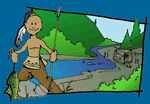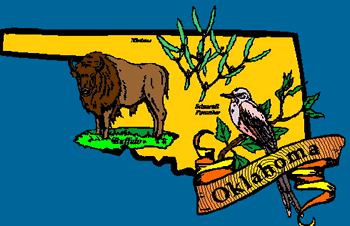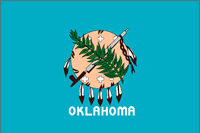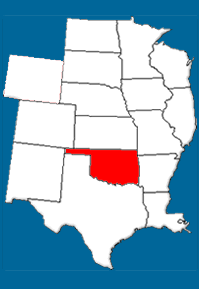 History:
The first Spanish explorer to enter the region was Francisco Vasquez de Coronado. In 1541 he led an expedition from New Mexico into Oklahoma. That same year, another Spaniard, Hernando DeSoto, explored the area. Both DeSoto and Coronado were in search of the legendary cities of gold that were believed to be located in that region.
In 1682 French explorer Robert Cavelier, Sieur de la Salle claimed all of the land drained by Mississippi River for France, including present-day Oklahoma. Soon after, French traders and trappers began to visit the region. In 1762, the land was ceded to Spain, but it was reclaimed by Napoleon for France in 1800 and sold to the United States in 1803 as part of the Louisiana Purchase. For the most part, this region remained in control of the nomadic native populations. No white settlements developed, and only traders, explorers, and adventuresome travelers visited present-day Oklahoma.
The Adams-Onis Treaty of 1819 established Oklahoma as the southwestern boundary of the United States. This Treaty also gave the Panhandle, the extreme northwestern portion of the present state, to Spain.
After 1819, the United States Government began encouraging Native Americans in the southeastern part of the country to move to the Oklahoma area. These Indians, part of the Cherokee, Chickasaw, Choctaw, Creek, and Seminole tribes, had lived in close contact with white settlers for many years and had adopted many of their customs. For that reason, they became known as the "Five Civilized Tribes."
Intense white pressure for the land occupied by these five tribes led President Andrew Jackson to force them into what became known as "Indian Territory." In preparation for this migration, the U.S. Army established Fort Towson and Fort Gibson in 1824. This sad migration between 1820 and 1842 is known as the "Trail of Tears." Many Indians died along the way.
These Native Americans settled on the hills and prairies of the eastern part of the Oklahoma region. In 1834 the area was officially established as the Indian Territory. Each of the five tribes formed a nation that consisted of a legislature, courts, and written laws. The United States government assured the Indians that they would own their own land "as long as grass shall grow and rivers run."
Gradually these Native American settlers built schools, churches, plantation-style farms, and ranches. Occasionally they traveled to the western part of the territory to hunt buffalo. Treaties protected them from white settlement and pioneers traveling west bypassed them.
The Civil War shattered the security and protection enjoyed by the Indians. The Five Civilized Tribes had come from the South and many of these Indians owned slaves. They sided with the Confederacy. As punishment for this allegiance, the U.S. government forced the Five Tribes to give up the western portion of their land. Soon other tribes from the East, including the Delaware and the Shawnee, were relocated to western Oklahoma. But large tracts of land in the territory still remained uninhabited.
Immediately after the Civil War, Texas cattlemen began to drive their herds across Oklahoma on their way to the railroad centers in Kansas. The most famous of these cattle trails was the Chisholm Trail. From 1866 to 1855, more than 6 million longhorn cattle crossed the Indian lands.
After the first railroad to cross Oklahoma was built in the 1870s, white settlers began to enter the region, despite the earlier laws and treaties with the Native Americans. By the 1880s, ranches - controlled by white cattlemen but owned by Native Americans - began to appear.
Land bordering the Indian Territory was filling up rapidly and very little free or cheap land was available. Soon the government was urged by white settlers to open up land in Indian Territory. In 1885, Congress authorized the president to begin negotiations with the Creek and Seminole tribes. As a result, the government purchased 3 million acres from the tribes and declared 1.9 million acres in central Oklahoma open for settlement. On April 22, 1889, nearly 50,000 people flooded the territory as a race for the best land began. Tent towns and farms were established, and the population began to increase dramatically.
In May of 1890, Congress established the Territory of Oklahoma, Guthrie became the capital, and the Panhandle was added. The Panhandle had become part of the United States in 1845 when Texas entered the Union.
White settlers were eager to possess the remaining lands in Indian Territory. In 1893, Congress created the Dawes Commission to implement a plan that would dissolve the individual nations and divide the remaining tribal lands into individual holdings. Initially, the Native Americans resisted, but in 1906, the plan was put into place as the result of a constitution drawn up by delegates from both territories. In 1907, the Indian Territory and Oklahoma Territory were united to form the state of Oklahoma. |









